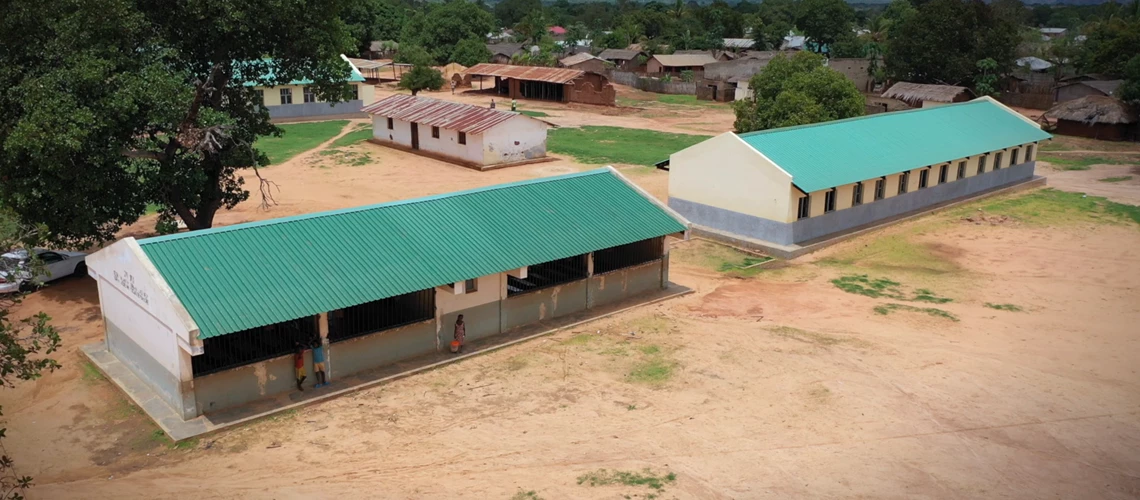 Rehabilitated, disaster-resilient school in Mozambique. Photo: GFDRR
Rehabilitated, disaster-resilient school in Mozambique. Photo: GFDRR
Nepal stands at a crucial juncture in its development trajectory, aiming to bolster its infrastructure, particularly its road networks, to enhance connectivity and propel socio-economic progress. However, amidst these aspirations lies vulnerability to climate and disaster risks such as floods and landslides. As suggested in the recent Nepal Country Climate and Development Report, to align with the country’s development goals and tackle these challenges, integrating climate resilience into infrastructure projects is paramount.
An exemplary initiative was the transformation of the Butwal-Gorusinghe-Chanauta road section in the Lumbini region of Nepal, a project undertaken through the Regional Bangladesh, Bhutan, India and Nepal (BBIN) Transport and Trade Facilitation Program. This project, addressing climate and disaster risks by adopting an Integrated Landscape Approach, became a beacon of change. By infusing green and climate-resilient measures into the roadway and surrounding areas, the project resulted in a resilient highway corridor strategy that will influence transport development across the whole country.
Key to the project’s success was its utilization of the Resilience Rating System (RRS), a methodology developed by the World Bank to evaluate a project’s resilience attributes. The RRS evaluates and rates investment projects from C to A+ in two complementary dimensions: resilience of a project’s design and resilience through a project’s outcomes. Through the rating system, the Nepal transport connectivity project earned an "AA" rating, a testament to its robust resilience measures and its contribution to enhancing the resilience of its beneficiaries.
The RRS evaluates and rates investment projects from C to A+ in two complementary dimensions: resilience of a project’s design and resilience through a project’s outcomes.
The RRS offers more than just ratings; it provides insights into projects’ economic viability against current and future climate and disaster scenarios through a climate risk stress test. The stress testing of the Nepal transport project revealed that a 3% incremental investment in resilience measures could yield substantial benefits, showcasing the immense value of integrating resilience into project planning.
The Nepal project was just one example how the RRS incentivized systematic identification and management of climate risks and broader resilience building. The RRS has been piloted across 21 countries and various sectors, emphasizing its adaptability and applicability in diverse settings. The experiences of piloting RRS and the lessons learned are summarized in a recent publication "Resilience Rating System: A Methodology for Building and Tracking Resilience to Climate Change - Synthesizing Key Lessons from IDA19 Piloting" and it highlights key lessons:
- Resilience Outcomes Beyond Finance: The impact of climate finance doesn’t solely define resilience outcomes. Capturing resilience impacts paints a comprehensive picture of adaptation and resilience. Take, for instance, a World Bank water supply project in Dili, Timor where allocating 10 percent of the investment towards institutional strengthening and a disaster risk management program went beyond the project's direct scope. However, this investment played a pivotal role in mainstreaming disaster risk management and climate change adaptation considerations into strategic, operational, and investment plans.
- Early Integration of Climate Risks: Incorporating climate risks early in project development allows for the exploration of resilient alternatives and better project design. For instance, a social safety nets and youth employment project in Sierra Leone integrated climate resilience measures in public works and analyzed the impact of climate risks on food security. This proactive approach, influenced by the Resilience Rating System team, ensured a more robust project design, showcasing the value of early climate risk integration in shaping effective solutions.
- Consistent Evaluation and Sector Specificity: A rating system like RRS offers a consistent way to evaluate and track resilience performance of projects and portfolios (such as public investments, infrastructure systems). Meanwhile, the rating approach needs sector-specific tailoring and guidance. A collaboration between the World Bank’s Agriculture and Food Global Practice, the RRS team, and the Food and Agriculture Organization (FAO) focused on identifying available data sources and literature for assessing the impacts of climate change and extreme events on agricultural production and prices and resulted in a guidance note developed by FAO for improving the RRS and climate risk stress testing for agriculture projects.
- Role of Climate Expertise: Effective project development requires embedded climate expertise to curate climate data, communicate impacts, and evaluate resilience options. For instance, an integrated urban development and resilience project in selected municipalities in Niger had a development objective that focused on addressing flood risks in the project design. Insights from the RRS team influenced considerations about extreme heat – a key climate hazard in Niger’s urban areas – alongside flood risks.
- Uncertainty Communication through Data and Analytical Tools: Robust climate and disaster risk data, along with analytical tools, are imperative for informed decision-making. The RRS team's provision of climate risk overviews, curation of climate data (such as in Climate Change Knowledge Portal) and information on climate impacts aids project teams in considering uncertain future climate impacts in project design.
The RRS marks a paradigm shift in climate-resilient investments, it empowers decision-makers to prioritize resilient projects and supports project developers in attracting financing.
The RRS marks a paradigm shift in climate-resilient investments, it empowers decision-makers to prioritize resilient projects and supports project developers in attracting financing. As the World Bank and the broader development community strive to increase climate results and impact, the continued application of RRS provides invaluable experiences, fostering more effective climate adaptation urgently needed by vulnerable countries and communities worldwide. The RRS is more than a rating system; it’s a pathway to a more resilience-driven and livable planet.




Join the Conversation